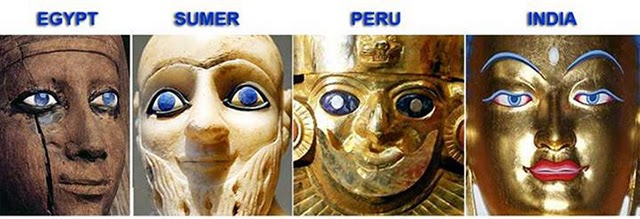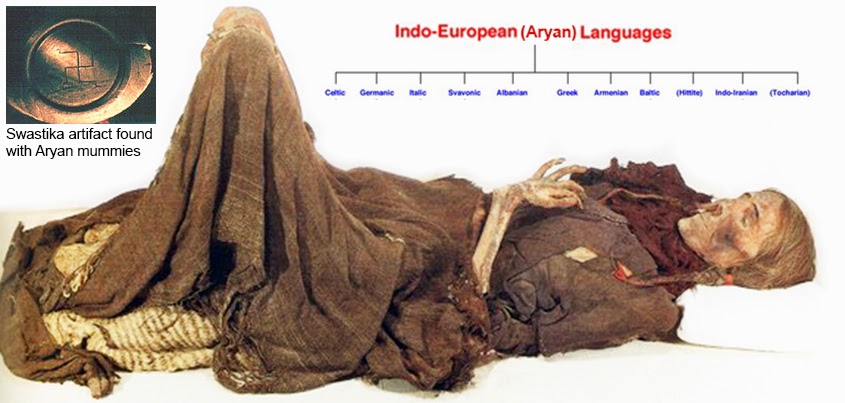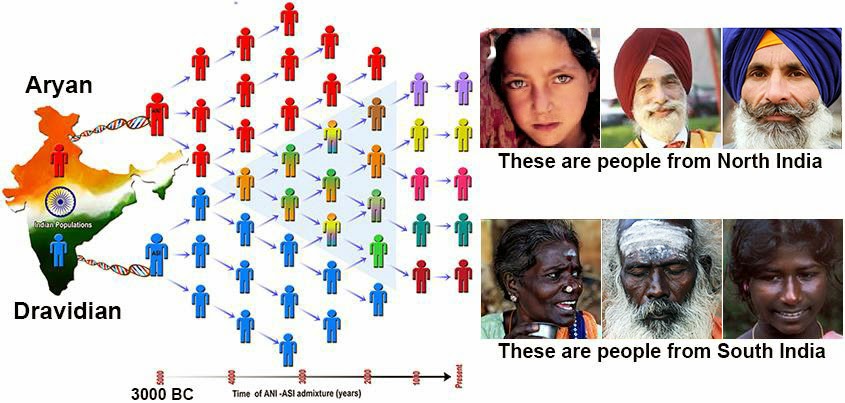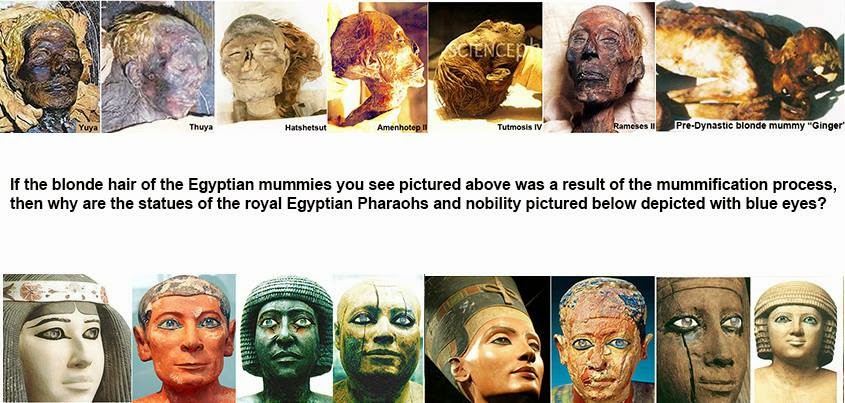In his 1896 book, The Swastika: The Earliest Known Symbol and its Migrations, Thomas Wilson, former curator of the Department of Prehistoric Anthropology in the U.S. National Museum, wrote of the swastika: “An Aryan symbol (卐) used by the Aryan peoples before their dispersion through Asia and Europe. This is a fair subject for inquiry and might serve as an explanation how…as a sacred symbol…the Swastika might have been carried to the different peoples and countries in which we now find it by the splitting up of the Aryan peoples and their migrations and establishment in the various parts of Europe.”
New genetic, archeological, and linguistic research has demonstrated that the supposedly "discredited" Aryan Race Theory may have been right after all. This theory argued that fair-haired, light-eyed Nordic agriculturalists, having tamed the horse and invented the wheel, conquered most of Europe, much of the Middle East and Northern India thousands of years ago, bringing with them the family of languages that used to be known as Aryan, and are now known as Indo-European, spoken from Ireland to India.
The Indo-European family of languages includes Modern English, German, French, Italian, Irish, Greek, Russian and indeed all European languages apart from Finnish, Hungarian and Basque, together with Iranian, Pashtu, Hindi, Gujarati, Bengali. Sinhalese and other Northern (or originally Northern) Indian languages. The kinship can still be seen in basic words like one, two, three--amhain, dha, tri in Irish, une, deux, trois in French, unus, duo, tres in Latin, eins, zwei, drei in German, einn, tver, thrir in Icelandic, odin, dva, tri in Russian, ena, duo, tria in Greek.
In the ancestor of the Indian branch of this language family, Sanskrit, it's eka, dva, treya. The people who spoke that language swept into the plains of Northern India almost 4,000 years ago as chariot-riding conquerors, calling themselves Aryas, "lords." On the way they gave their name to Iran, derived from "Aryan."
Others swept eastward, where for a thousand years an Indo-European language, Tocharian, was spoken in what is now Chinese Turkestan. Suggestion that this ancient race of more-advanced conquerors were blonde-haired, blue-eyed Nordics were dismissed since 1945 as "discredited"--i.e., Politically Incorrect rather than proved wrong. Linking race and culture was a big academic career-ending no-no.
But meanwhile archaeologists and historians of languages, avoding such explosive topics, managed to link the Proto-Indo-Europeans, the conquerors before they exploded from their homeland, to the Bronze Age Androvonovo Culture, based in western Siberia and what is now Kazakhstan.
The remains of the people themselves were buried in great mounds, like later Viking and Anglo-Saxon barrows and howes, known as kurgans. These are similar to the ancient native American mounds found scattered all over the Mississippi valley.
Now geneticists have examined the DNA of these Proto-Indo-Europeans, or Aryans as they probably called themselves and were called until the PC shutters came down, extracted from their ancient tombs.
The results are deeply Politically Incorrect, as revealed in three seminal papers:
- C. Bouakaze et al, First successful assay of Y-SNP typing by SNaPshot minisequencing on ancient DNA, International Journal of Legal Medicine, vol 121 (2007), pp. 493-499.
- C. Keyser et al, Ancient DNA provides new insights into the history of South Siberian Kurgan people, Human Genetics, vol. 125, no. 3 (September 2009), pp. 395-410.
- C. Lalueza-Fox et al, 2004. Unraveling migrations in the steppe: mitochondrial DNA sequences from ancient central Asians, Unravelling migrations in the steppe: mitochondrial DNA sequences from ancient central Asians.
It turns out that genetically the Proto-Indo-Europeans buried in the steppe kurgan graves 5,000 years ago were identical with modern Western and Northern Europeans belonging to the Nordic sub-race. The majority had light hair and blue and green eyes. It wasn't until much later that the gene complexes associated with other racial
types appeared in the Central Asian steppe north of the deserts and irrigated
farming zone.
The typical steppe nomad horseman before the Turks and later the Mongols spread
west, and the typical Aryan who brought what is now Hinduism to India and gave
his speech to almost every nation from the Bay of Bengal to the Atlantic looked,
it is now clear from the genetic evidence, like a modern northern European.
And indeed
do the mummified remains of the Tocharian speakers in what is now Chinese
Turkestan, who have blonde and red hair. So, incidentally, did many early Pharaohs of Egypt.
It is also clear from the appearance of most speakers of Indo-Aryan languages today in Pakistan, Northern India, Blackburn, Leicester and a corner shop near you, that significant interbreeding has occurred between conquerors and conquered in the 4,000 years since.













interesting
ReplyDeleteSignificant!
ReplyDeleteA lot more to be know here.
ReplyDeletesuperbe !!!
ReplyDeleteCool
ReplyDeleteWhere is albanian language in aryan family tree?
ReplyDeleteI love albania
ReplyDeletegreat ...lots of knowledge...expact much more.....thanks
ReplyDeleteThank you for the info.
ReplyDeleteSo, the europeans with brown or dark eyes, are supossed to be mixed with other kinf of human race from other place?
ReplyDeleteMr. Atlantean Gardens .. know the facts correctly!
DeleteVinca Proto-Letter, Serbia 8000 BC , check about swastica and other symbols of Danube civilisation.
ReplyDeleteProbably crossbreading with neanderthals(up north). Stronger sturdier build crossed with human intelligence.
ReplyDeleteGreat warriors to be used as conquerors. Swastika could also be compared to expansion from black sea area.(Maybe some have longer plans than others)
Good thing we got genetics, replication & stuff nowadays so we hopefully can put an end to human breeding programs & experiments. We shouldn't be treated as cattle.
It means Brahimns are not Indian, they native from Eurasian.
ReplyDeleteHAPLOGROUP R1a
ReplyDeleteLet us learn about the haplogroups starting from undoubtedly the most important one for us since over 50% of inhabitants of our country (Poland) as well as inhabitants of neighbouring countries own this haplogroup. The mutation occurred about 21.000 years ago on the territories of southern Russia. As far as our territories are concerned, this haplogroup is represented by the culture of lace pottery from 3300 – 2500 BC. Expansion of this haplogroup is related to domestication of the horse on the steppes of Eurasia. Those people were so expansionist that today they make up over 20% of population of such distant areas as the western part of Scandinavia or Iceland. It is worth mentioning that 80% of population belonging to the highest castes in India are owners of this haplogroup.
HAPLOGROUP R1b
To talk about this group, it is significant to mention the history of Europe from the period of AD
V – VIII. Until present that period in history has been described as expansion of Germanic tribes who pushed off the Celts onto territories of present Britain, Wales, Scotland. Nevertheless, let us compare these pieces of information with the frequency of the presence of the haplogroup R1b on those territories. Insofar as in the countries considered Germanic now (Germany, Austria, Switzerland), the R1b haplogroup is present at 40 – 50% of people, insomuch in Ireland, Scotland, Wales, western France where we talk about descendants of the Celts, this group is present at about 80% of people. This group is evidently associated with the Celts. What is noticeable, this haplogroup is younger than R1a for it appeared about 20.000 years ago in the areas of the the Caspian Sea and Central Asia.